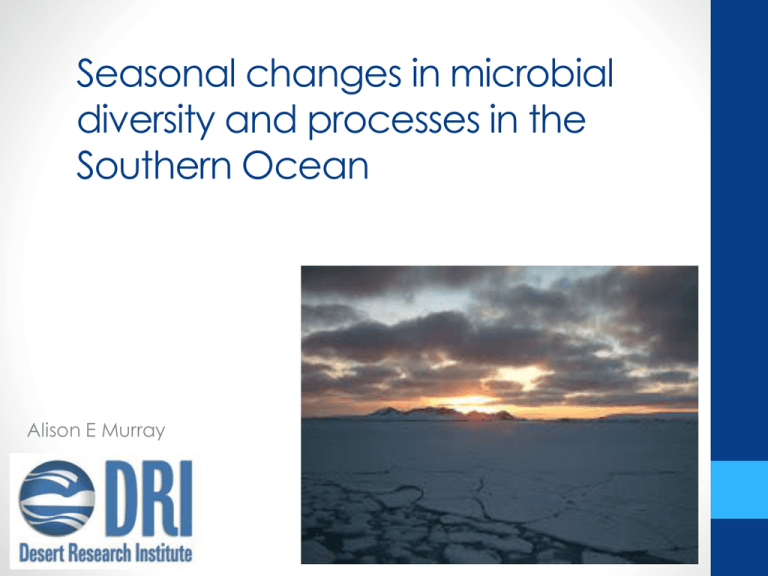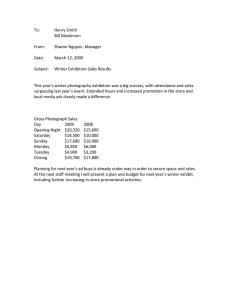Seasonal changes in microbial diversity and processes in the Southern Ocean
advertisement

Seasonal changes in microbial diversity and processes in the Southern Ocean Alison E Murray Bacterioplankton play critical roles in C-N-S-P-Fe cycling Carbon Cycle Sulfur Cycle Iron Cycle Nitrogen Cycle Phosphorus Cycle Questions • 1. Seasonal turnover of picoplankton • 2. Winter picoplankton processes • 3. Sea ice connections to upper ocean 1° and 2° productivity • 4. Changes in remineralization as a result of climate change Questions1 • Previous results from coastal Antarctic Peninsula studies have indicated substantial turnover of picoplankton groups (species/ribotypes) over the seasonal cycle – (i) Is this a pervasive feature of the southern ocean? (ii) What are the drivers of these shifts? and (iii) Are they important to understanding of Southern Ocean biogeochemical function? Seasonal variation: Picoplankton composition varies significantly 2001-02 1996-97 Bacterial community structure: DGGE As FISH-stained cells Archaeal abundance As RNA Murray et al. 1998, Appl. Environ. Microbiol. Murray and Grzymski, 2007 Phil. Trans. Roy. Soc. Lond. B; Church et al. Limnology and Oceanography, 2003 Winter-Archaea a Winter Summer Bact. Bact. Seasonal differences in rRNA gene sequences between summer and winter (Coastal Antarctic Peninsula 28 clusters Approx. 18-38% of the winter plankton are chemolithoautotrophs Conserved gene comparisons (COGs) Summer vs. Winter: Summer: Feb Archaeal COGS •Heme degredation/utilization •Iron utilization protein •Siderophore interacting protein •Ferritin •Fe Transport •Polyphosphate kinase 360 •Phosphonate utilization •ABC phosphate transport •PTS System •Pullulanase •1,4 glycosidases •Xylosidases 1680 •Glycogen utilization •Trehalose utilization Winter: Aug •Siderophore transport & biosynthesis •Bacterioferritin •High-affinity Fe 2+ permease • Nitrate & nitrite reductase 584 • Phosphate transporter, regulators, porins •Nitrate/nitrite transporters •Nitric oxide reductase transporters •RuBisCO *** •Bifunctional dissimilatory sulfite reductase Picoeukaryotes dominate late winter chlorophyll signal Chlorophyll a mg per L Picoeukaryote cells per mL AMLR Study Area Questions 2 • Gaps in biological process data from polar winter are pervasive; (i) are “we” missing important processes?[chemolithoautotrophy, mixotrophy, low light adapted phototrophy?] (ii) By understanding winter processes (primary and secondary production & mixotrophy) can we improve the understanding of winter biogeochemical cycling? Further, how do these relate to processes in the mesopelagic Gaps in winter microbial studies WAP: LTER Stn. B 2002-2009 Ducklow et al. 2011 AME Ross Sea 1996-1997 mMol C m-2 d-1 Ducklow et al. 2001 DSRII Dark carbon fixation -1 -1 pMC day Chlorophyll a μg L 4e+5 0.30 0.24 3e+5 0.18 2e+5 0.12 1e+5 0.06 0 0.00 40 DOC & NO2+3-2 μM 200 BP DCF 160 120 30 20 80 10 40 0 0 50 2.6 -2 NO2+3 45 2.4 DOC PO4-2 40 2.2 35 2.0 30 1.8 25 20 1.6 200 210 220 230 240 250 260 Julian Day -2 Bacterial cells Chla PO4 μM 5e+5 Biomass production nMC day-1 Bacterial cells mL -1 Coastal WAP Winter Time Series (IPY) 8e+5 6e+5 + NH4 additions 4e+5 2e+5 16 12 8 4 0 500 300 400 300 200 200 100 100 0 32 30 PO4-2 μM NO2+3 μM Early August rate No additions SO3-2 & S2O3-2 additions μ13C POC (>0.22 μm) Biomass production -1 μM C day 1e+6 Dark carbon fixation pMC day-1 Bacterial cells mL-1 Inorganic additions to seawater incubations (10 day): dark carbon fixation is stimulated by N and S additions 28 26 24 22 244 246 248 250 252 254 256 Julian Day 0 2.1 2.0 1.9 1.8 1.7 1.6 1.5 244 246 248 250 252 254 256 Julian Day Chemolithoautotrophic RuBisCO is abundant and expressed in Antarctic winter samples – and NOT in summer 12000 Copy Number • Assay environmental samples collected in the IPY • 6 summer (1 site) • 20 winter (3 sites) Stn B DNA 10000 Stn B cDNA 8000 Stn SI cDNA 6000 Offshore Stations cDNA Stn SI DNA Offshore Stations DNA 4000 2000 0 Feb Apr Jun Date (2008) Aug Oct Metaproteome comparisons support seasonal differences Williams et al. 2012 ISMEJ 6:1883-1900 Conceptual model for ecosystem differences between summer and winter Dark CO2 fixation estimated at 0.05 Gt Carbon in upper 100 m of the water carbon (Grzymski et al.2012 ISMEJ & Manganelli et al. 2009 PlosOne) Grzymski et al. 2012 ISMEJ Questions 3 • Sea ice is a key habitat for diatom growth, and microbial cycling of organic matter; (i) How do changes in sea ice (timing of formation… thickness etc.) influence picoplankton-driven biogeochemical cycling? Changes in ice season annual duration Sea ice cover derived from scanning multichannel microwave radiometer – Special Sensor Microwave/Imager (SMMR/SSM/I); Ducklow et al. 2013 Oceanogr. …changes in sea ice cascade through the ecosystem – including the microbes. 14 yr. study at Ryder Bay, Rothera: Venables et al. 2013 Sea ice Stratification Phytoplankton & PP Bacterial production Ducklow et al. 2012 J. Mar. Sys. Sea ice roles in micronutrient, DOC and microbial seeding?? • Strengthen research on establishing understand of trophic connections between ice-associated and underlying algae and bacteria (when and where does coupling occur?) • How will changes in sea-ice associated DOC and POC influence the microbial loop? Sea ice Stratification Phytoplankton & PP Bacterial production Questions 4 • The mesopelagic and possibly bathypelagic zones of the Southern Ocean are major zones of carbon remineralization; • (i) how will shifts in stratification and nutrient distributions with global warming influence respiratory processes? • (ii) given the abundance of chemolithoautotrophic plankton below the oxycline, what is their influence on carbon cycling? • (iii) how will changes in POC (e.g. diatoms to smaller cells) influence remineralization processes? Microbes and activities in the deep • High bacterial biomass and protein production rates were observed at depth in iceberg alley • Transmissivity increased at depth Microbes and associated detrital material in the sediment trap A. Bacterial cells are on average much larger than those suspended in the water column B. Protein production rates are high in LST samples LST EEA 167.9 Seawater (average) 23.7±18.8 SEEx (average) 62.7±56.6 1003.4 226.3 18.7±12.5 25.2±12.6 28.7±14.7 Alkaline phosphatase (raw fluorescence) N-acetylglucoasmine (raw fluorescence) C. Particulate (LST) ectoenzyme activities are 3-35X higher than seawater and seawater culture rates B-glucosidase (raw fluorescence) 36.32 167.32 42.64 2.83 Aminopeptidase (raw fluorescence) IB03-071_LST_C-18-1 IB03-095_LST_C18-2 IB03-168_LST_REF IB03-096_LST_10nm pM leucine x hr-1 Sample origin LST Deployment 4812 257.7±169.0 Recommended Field Studies • Incorporate microbial process studies that look at light and dark carbon fixation, in addition tor recycling of carbon in the mesopelagic • Expand genomic and proteomic studies in ocean realms, and use this information and develop sensitive assays that can be used as indicators of biogeochemical processes and to augment models • Advance the understanding of sea ice and links between ice-associated processes and underlying waters (micro and macronutrients & and trophic interactions) • Quantify the relationships between respiration and carbon export (coastal/open ocean/sea ice/areas of upwelling/mixing) Acknowledgements WAP Bacterioplankton IPY Team • Hugh Ducklow, Matt Erickson, Kristen Myers – MBL, Woods Hole • Jeff Ghiglione, LOMIC, Banyuls-Sur-Mer • Carol Arnosti and Sherrif Ghobrial, UNC • Joe Grzymski, Christian Riesenfeld and Vivian Peng – DRI Logistic and data support from: Raytheon Polar Sciences Company, Palmer LTER




